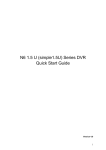Download Standalone DVR Quick Start Guide
Transcript
2U Series DVR Quick Start Guide 1 Table of Contents 1 Hardware Installation and Connection..........................................................................5 1.1 Check Unpacked DVR ..........................................................................................5 1.2 About Front Panel and Real Panel .....................................................................5 1.3 After Remove the Chassis....................................................................................5 1.4 HDD Installation .....................................................................................................5 1.4.1 8 HDD series................................................................................................5 1.4.2 4 HDD Series ...............................................................................................6 1.5 Rack Installation.....................................................................................................7 1.6 Front Panel .............................................................................................................7 1.7 Rear Panel ..............................................................................................................9 1.8 Connection Sample .............................................................................................10 1.9 Alarm Input and Output Connection .................................................................10 1.9.1 Alarm Input and Output Details...............................................................11 1.9.2 Alarm Input Port.........................................................................................11 1.9.3 Alarm Output Port......................................................................................12 2 Overview of Navigation and Controls..........................................................................13 2.1 Login, Logout & Main Menu ...............................................................................13 2.1.1 2.1.2 2.1.3 2.1.4 Login............................................................................................................13 Main Menu..................................................................................................13 Logout .........................................................................................................14 Auto Resume after Power Failure ..........................................................14 2.2 Recording Operation ...........................................................................................14 2.2.1 Live Viewing ...............................................................................................14 2.3 Record Setup (Schedule) ...................................................................................15 2.3.1 2.3.2 2.3.3 2.3.4 2.3.5 2.3.6 Schedule Menu..........................................................................................15 Manual Record ..........................................................................................15 Encode ........................................................................................................16 Snapshot.....................................................................................................17 Image FTP..................................................................................................18 Snapshot Disk (For special series only) ................................................18 2 2.3.7 Search and Playback................................................................................19 2.3.8 Basic Operation .........................................................................................20 2.4 Network Setup......................................................................................................22 2.5 Pan/Tilt/Zoom .......................................................................................................22 2.5.1 PTZ Setup ..................................................................................................23 2.5.2 PTZ Operation ...........................................................................................23 2.5.3 3D Intelligent Positioning Key .................................................................24 3 Web Client Operation ....................................................................................................25 3.1 Network Connection ............................................................................................25 3.2 Login ......................................................................................................................25 3.3 Main Window ........................................................................................................25 3 Welcome Thank you for purchasing our DVR! This quick start guide will help you become familiar with our DVR in a very short time. Here you can find hardware installation,cable connection information and general operations such as system setup, record, search, backup, alarm setup, PTZ operation, also here you can find web operation instruction. Before installation and operation, please read the following safeguard and warning carefully! Important Safeguard and Warning 1.Electrical safety All installation and operation here should conform to your local electrical safety codes. We assume no liability or responsibility for all the fires or electrical shock caused by improper handling or installation. 2.Transportation security Heavy stress, violent vibration or water splash are not allowed during transportation, storage and installation. 3.Installation Keep upwards. Handle with care. Do not apply power to the DVR before completing installation. Do not place objects on the DVR 4.Qualified engineers needed All the examination and repair work should be done by the qualified service engineers. We are not liable for any problems caused by unauthorized modifications or attempted repair. 5.Environment The DVR should be installed in a cool, dry place away from direct sunlight, inflammable, explosive substances and etc. 6. Accessories Be sure to use all the accessories recommended by manufacturer. Before installation, please open the package and check all the components are included: Contact your local retailer ASAP if something is missing in your package. 4 1 Hardware Installation and Connection Note: All the installation and operations here should conform to your local electric safety rules. 1.1 Check Unpacked DVR When you receive the DVR from the forwarding agent, please check whether there is any visible damage. The protective materials used for the package of the DVR can protect most accidental clashes during transportation. Then you can open the box to check the accessories. Please check the items in accordance with the list on the warranty card (Remote control is optional). Finally you can remove the protective film of the DVR. Note Remote control is not a standard accessory and it is not included in the accessory bag. 1.2 About Front Panel and Real Panel For detail information of the function keys in the front panel and the ports in the rear panel, please refer to the User’s Manual included in the resource CD. The model in the front panel is very important; please check according to your purchase order. The label in the rear panel is very important too. Usually we need you to represent the serial number when we provide the service after sales. 1.3 After Remove the Chassis Please check the data cable, power cable, COM cable and main boar cable connection is firm or not. 1.4 HDD Installation 1.4.1 8 HDD series This series DVR has 8 SATA HDDs. Please use HDD of 7200rpm or higher. It has no requirement for HDD capacity. You can refer to the user’s manual for recommended HDD brand. Please follow the instructions below to install hard disk. 1. Loosen the screws of the 2. Remove the HDD upper 3. Now you can see the bottom upper cover. bracket bracket 5 4. Line up the HDD to the four holes of the 5. Use four screws to fix HDD. HDD 6. Install the upper bracket and then Use screws to fix HDD in the bracket. bracket. 7. Unfasten the HDD power 8. Insert the HDD power 9. Use the special data cable to cable. cable. connect the HDD and the SATA port. Close the chassis and fix the screws to secure firmly. Important If the HDD amount is less than four, you do not need to install the HDD bracket. When there is a bracket, please make sure the installation direction of HDDs is the same. 1.4.2 4 HDD Series This series DVR has 4 SATA HDDs. Please use HDD of 7200rpm or higher. It has no requirement for HDD capacity. You can refer to the appendix for recommended HDD brand. Please follow the instructions below to install hard disk. 1. Loosen the screws of the 2. Line up the HDD to the four upper cover. holes of the HDD bracket. 3. Use four screws to fix HDD. 6 4. Unfasten the HDD power 5. Use the special data cable to 6. Insert the HDD power cable. cable. connect the HDD and the SATA Close the chassis and fix the port screws to secure firmly. After completing HDD installation, please check connection of data ribbon and power cord. 1.5 Rack Installation The DVR occupies 2 rack units of vertical rack space. z Use twelve screws to fix the unit z Please make sure the indoor temperature is below 35℃ (95°f). z Please make sure there is 15cm (6 inches) space around the device to guarantee sound ventilation. z Please install from the bottom to the top. z If there are more accessories connected in the rack, please take precaution measures in case the rack power is overload. After completing HDD installation, please check connection of data ribbon and power cord. 1.6 Front Panel The front panel is shown as in Figure 1-1. Figure 1-1 Please refer to the following sheet for front panel button information. Name Icon Function Power button, press this button for three seconds to boot up or shut down DVR. Power button Number button 0-9 Input Arabic number Switch channel Input number more than 10 -/-- If you want to input a number more than 10, please click this button and then input. 7 Shift Up/ Down S、T In textbox, click this button to switch between numeral, English(Small/Capitalized),donation and etc. In preview window, press it for three seconds to switch between TV/VGA. Enable or disable tour. Activate current control, modify setup, and then move up and down. Increase/decrease numeral. Assistant function such as PTZ menu. Shift current activated control, and then move left and right. Left/ Right W ESC ESC X When playback, click these buttons to control playback bar. Go to previous menu, or cancel current operation. When playback, click it to restore real-time monitor mode. Confirm current operation Enter ENTER Go to default button Go to menu Record REC Slow play Manually stop/start recording, working with direction keys or numeral keys to select the recording channel. Multiple slow play speeds or normal playback. One-window monitor mode, click this button to display assistant function: PTZ control and image color. Backspace function: in numeral control or text control, press it for 1.5seconds to delete the previous character before the cursor. In motion detection setup, working with Fn and direction keys to realize setup. Assistant Fn In text mode, click it to switch between numeral, English character(small/capitalized) and etc. In HDD management interface, you can click it to switch HDD record information and other information (Menu prompt) Realize other special functions. Fast play Play previous Reverse/Pau se Various fast speeds and normal playback. _ W In playback mode, playback the previous video In normal playback or pause mode, click this button to reverse playback In reverse playback, click this button to pause playback. 8 f Play Next In playback mode, playback the next video In menu setup, go to down ward of the dropdown list. Play/Pause f In normal playback click this button to pause playback In pause mode, click this button to resume playback. Window switch Mult Click it to switch one-window/multiple-window. Jog(inner dial) In real-time monitor mode it works as left/right direction key. Playback mode, counter clockwise to forward and clock wise to backward. Up/down direction key. Playback mode, turn the inner dial to realized frame by frame playback. (Only applies to some special versions.) USB port To connect USB storage device, USB mouse. Shuttle(outer ring) Remote control indication light ACT Remote control indication light Status indication light Status If there is Fn indication light, current status indication light is null. Power indication light PWR Power indication light Record light 1-16 System is recording or not. It becomes on when system is recording. IR Receiver IR It is to receive the signal from the remote control. 1.7 Rear Panel This series DVR rear panel is shown as below. See Figure 1-2. Figure 1-2 Please refer to the following sheet for detail information. 1 Power button 2 Power input port 3 Fan 9 4 5 6 7 8 9 10 11 12 13 Loop video output 1st to 4th-channel audio input Video input DB25 port (5th to 16th-channel audio input port) Audio output Bidirectional talk input port Bidirectional talk output port Network port eSATA port RS232 port 14 15 16 17 18 19 USB port HDMI port Video VGA output Alarm input/alarm output/RS485 port Video CVBS output Video matrix output When connect the Ethernet port, please use straight cable to connect the PC and use the crossover cable to connect to the switcher or router. 1.8 Connection Sample Please refer to Figure 1-3 for connection sample. Figure 1-3 1.9 Alarm Input and Output Connection There are two alarm input types for you to select: normal open (NO) and normal close (NC). 10 1.9.1 Alarm Input and Output Details You can refer to the following sheet and Figure 1-4, Figure 1-5 for alarm input and output information. Figure 1-4 In the first line, from the left to the right,: 1,2,3,4,5, 6 , 7 , 8 , 9 , 10 , 11 , 12 , 13 , 14 , 15,16 In the second line, from the left to the right: NO1 C1, NO2 C2, NO3 C3, NO4 C4, NO5 C5 NC5 CTRL 12V +12V ALARM 1 to ALARM 16. The alarm becomes active in low voltage. The first four are four groups of normal open activation output (on/off button) NO5 C5 NC5 is a group of NO/NC activation output (on/off button) Control power output. You need to close the device power to cancel the alarm. It is external power input. Need the peripheral equipment to provide +12V power (below 1A). Earth cable. 485 A/B 485 communication port. They are used to control devices such as PTZ. Please parallel connect 120TΩ between A/B cables if there are too many PTZ decoders. 1.9.2 Alarm Input Port Please refer to the following sheet for more information. z 4/8/16-ch grounding alarm inputs. (Normal open or Normal close type) z Please parallel connect COM end and GND end of the alarm detector (Provide external power to the alarm detector). z Use the controllable +12V power to reset the smoke sensor remotely. z Please parallel connect the Ground of the DVR and the ground of the alarm detector. z Please connect the NC port of the alarm sensor to the DVR alarm input(ALARM) z Use the same ground with that of DVR if you use external power to the alarm device. 11 Figure 1-5 1.9.3 Alarm Output Port z z z z 6 ways relay alarm output (NO contact). Provide external power to external alarm device. For controllable +12V, it can be used to provide power to devices such as reset smoke sensor. To avoid overloading, please read relay parameters sheet in the User’s Manual carefully. RS485 A/B cable is for the A/B cable of the PTZ decoder. 12 2 Overview of Navigation and Controls Before operation, please make sure: z You have properly installed HDD and all the cable connections. z The provided input power and the device power are matched. z The external power shall be: AC90~264V 50+2% Hz z Always use the stable current, if necessary UPS is a best alternative measure. 2.1 Login, Logout & Main Menu 2.1.1 Login After system booted up, default video display is in multiple-window mode. Click Enter or left click mouse, you can see the login interface. See Figure 2-1. System consists of four accounts: Username: admin. Password: admin. (administrator, local and network) Username: 888888. Password: 888888. (administrator, local only) Username: 666666. Passwords: 666666(Lower authority user who can only monitor, playback, backup and etc.) z Username: default. Password: default(hidden user) You can use USB mouse, front panel, remote control (not included in the accessory bag) or z z z keyboard to input. About input method: Click to switch between numeral, English character (small/capitalized) and denotation. Note: For security reason, please modify password after you first login. Within 30 minutes, three times login failure will result in system alarm and five times login failure will result in account lock! Figure 2-1 2.1.2 Main Menu After you logged in, the system main menu is shown as below. See Figure 2-2. There are total six icons: search, information, setting, backup, advanced and shutdown. You can move the cursor to highlight the icon, and then double click mouse to enter the submenu. 13 Figure 2-2 2.1.3 Logout There are two ways for you to log out. The first one is from menu option: In the main menu, click shutdown button, you can see an interface is shown as below. See Figure 2-3. Figure 2-3 There are several options for you. See Figure 2-4. Figure 2-4 The other ways is to press power button on the front panel for at least 3 seconds, system will stop all operations. Then you can click the power button in the front panel to turn off the DVR. Please note, before you replace the HDD, do remember shutting down the device and unplug the power cable. 2.1.4 Auto Resume after Power Failure The system can automatically backup video and resume previous working status after power failure. 2.2 Recording Operation 2.2.1 Live Viewing After you logged in, the system is in live viewing mode by default. You can see system date, time and channel name. If you want to change system date and time, you can refer to general settings (Main Menu->Setting->General). If you want to modify the channel name, please refer to the display settings (Main Menu->Setting->Display) 14 1 Recording status 3 Video loss 2 Motion detection 4 Camera lock 2.3 Record Setup (Schedule) Note: You need to have proper rights to implement the following operations. Please make sure the HDDs have been properly installed. After the system booted up, it is in default 24-hour regular mode. You can set record type and time in schedule interface. 2.3.1 Schedule Menu In the main menu, from Setting to Schedule, you can go to schedule menu. See Figure 2-5. There are total six periods. z Channel: Please select the channel number first. You can select “all” if you want to set for the whole channels. z Week day: There are eight options: ranges from Saturday to Sunday and all. z Pre-record: System can pre-record the video before the event occurs into the file. The value ranges from 1 to 30 seconds depending on the bit stream. z Redundancy: System supports redundancy backup function. You can highlight Redundancy button to activate this function. Please note, before enable this function, please set at least one HDD as redundant. (Main menu->Advanced->HDD Management). z Snapshoot: You can enable this function to snapshoot image when alarm occurs. z Record types: There are three types: regular, motion detection (MD) and Alarm. Please highlight icon to select the corresponding function. After completing all the setups please click save button, system goes back to the previous menu. At the bottom of the menu, there are color bars for your reference. Green color stands for regular recording, yellow color stands for motion detection and red color stands for alarm recording. Figure 2-5 2.3.2 Manual Record Note: Please make sure you have the record operation right and you have properly installed the formatted HDD. 15 You can right click mouse or in the main menu, from Advanced->Manual Record to go to record interface. There are three statuses: schedule/manual/stop. Highlight icon“○” to select corresponding channel. See Figure 2-6. z Manual: The highest priority. After manual setup, all selected channels will begin ordinary recording. z Schedule: Channel records as you have set in recording setup (Main Menu->Setting>Schedule) z Stop: All channels stop recording. Figure 2-6 2.3.3 Encode Encode interface is shown as in Figure 2-7. z Channel: Select the channel you want. z Compression: System supports H.264. z Resolution: System supports various resolutions, you can select from the dropdown list. For this model, main stream supports D1/CIF/QCIF. Please note the resolution may vary due to different channels. The extra stream supports QCIF only. z Frame rate: It ranges from 1f/s to 25f/s in NTSC mode and 1f/s to 30f/s in PAL mode. Note: For 4HDDs series, we take 8-ch series DVR for example; you can refer to the following information: If the 1-channel resolution is D1and the frame rate is more than 6f/s, then the rest seven channels (the second channel to the eights channel) resolution shall be CIF or QCIF. If the 1-channel resolution is D1 and the frame rate is or less than 6f/s, then the rest seven channels (the second channel to the eighth channel) resolution shall be D1/CIF/QCIF. Right now in D1 resolution, the max frame rate is 6f/s. z Bit rate type: system supports two types: CBR and VBR. In VBR mode, you can set video quality. z Quality: There are six levels ranging from 1 to 6. The sixth level has the highest image quality. z Video/audio: you can enable or disable the video/audio. Please note the video is enabled for main stream by default. For extra stream, please enable video first and then enable audio. z Snapshot: Click snapshot button, you can see it contains the four items: mode/image size/image quality/snapshot frequency. Please refer to chapter 2.3.3 for detail information. Please highlight icon to select the corresponding function. 16 Figure 2-7 2.3.4 Snapshot 2.3.4.1 Schedule Snapshot In Encode interface, click snapshot button to input snapshot mode, size, quality and frequency. In General interface please input upload interval. In Schedule interface, please enable snapshot function. Please refer to the following figure for detail information. See Figure 2-8. Figure 2-8 2.3.4.2 Activation Snapshot Please follow the steps listed below to enable the activation snapshot function. After you enabled this function, system can snapshot when the corresponding alarm occurred. z In Encode interface, click snapshot button to input snapshot mode, size, quality and frequency. z In General interface please input upload interval. z In Detect interface please enable snapshot function for specified channels. Or in Alarm interface please enable snapshot function for specified channels. Please refer to the following figure for detail information. See Figure 2-9. Figure 2-9 17 2.3.4.3 Priority Please note the activation snapshot has the higher priority than schedule snapshot. If you have enabled these two types at the same time, system can activate the activation snapshot when alarm occurs, and otherwise system just operates the schedule snapshot. 2.3.5 Image FTP In Network interface, you can set FTP server information. Please enable FTP function and then click save button. See Figure 2-10.Please refer to the User’s Manual included in the resource CD for detailed information. Please boot up corresponding FTP server. Please enable schedule snapshot or activation snapshot (Chapter 2.3.3) and then system can upload the image file to the FTP server. Please input the corresponding information here, if you just upload the image FTP. Figure 2-10 2.3.6 Snapshot Disk (For special series only) Set one disk as snapshot (Main menu->Advanced->HDD management) and then click execute button. See Figure 2-11. System needs to reboot to get current setup activated. Figure 2-11 All scheduled snapshot files or activated snapshot files will be memorized in the snapshot disk. You can search the corresponding images via Web. See Figure 2-12. 18 Select a file and then click here to view image content. Select search engine here You can see result here. Double click file name, you can view the image content. There are max 100 files in one Figure 2-12 page. Click here to view more. 2.3.7 Search and Playback Click search button in the main menu, search interface is shown as below. See Figure 2-13. Usually there are three file types: z R: Regular recording file.z A: External alarm recording file. z M: Motion detection recording file 19 Playback control bar Select playback mode here: 4-ch or All-channel Set search setup here (Time/Channel/Type) Figure 2-13 Please refer to the following Serial Number 1 2 3 4 5 6 7 8 9 10 11 12 13 14 sheet for more information. Function Play Backward Stop Slow play Fast play Previous frame Next frame Volume Previous file Next channel Next file Previous channel Search Backup 2.3.8 Basic Operation 2.3.8.1 Playback Operation There are various search modes: video type, channel number or time. The system can max display 128 files in one screen. You can use page up/down button to view if there are more than one page. Select the file name and double click mouse (or click enter button), you can view file content. 2.3.8.2 Playback Mode 20 There are two playback modes: 4-ch and all-channel. In 4-ch playback mode, you can select the 1/2/3/4-ch playback according to your requirement. In all-channel mode, system can playback in full channels. Please note the 4-ch has no all-channel playback mode. 2.3.8.3 Accurate playback Input time (h/m/s) in the time column and then click playback button, system can operate accurate playback. 2.3.8.4 Synchronized playback function when playback During playback process, click numeral key, system can switch to the corresponding channel video of the same time. 2.3.8.5 Digital zoom When the system is in full-screen playback mode, drag your mouse in the screen to select a section and then left click mouse to realize digital zoom. You can right click mouse to exit. 2.3.8.6 File backup System supports backup operation during search. You can draw a √ before file name (multiple choices). Then click backup button (Button 14 in Figure 2-13). 2.3.8.7 Calendar Click calendar icon in Figure 2-13, system pops up a calendar for your reference. The highlighted date means there are record files in that day. You can click blue date to view file list. In t he following interface you can see there are video files in March 13th and 14th. Double click the date to view file list. t Figure 2-14 2.3.8.8 Slow playback and fast playback Please refer to the following sheet for slow play and fast playback function. Button Fast play button Slow play button ► Play/Pause► Illustration In playback mode, click this button to switch between various fast play modes such as fast play 1,fast play 2 and more. In playback mode, click this button to switch between various slow play modes such as slow play 1 or slow play 2. Remarks Frame rate may vary due to different versions. In slow playback mode, click this button to switch between play/pause modes. 21 In playback mode, you can click │_ and ` to view previous or next video in current channel. Previous/next 2.3.8.9 Backward playback and frame by frame playback Button Backward play: _ in playback interface. Manual playback frame by frame. Illustration In normal playback mode, left click backward play button_, system begins backward playback. Double click backward play button again, system goes to pause mode. Click pause button in normal playback mode, you can use W│ and │X to view frame by frame. Remarks When system is in backward play or frame by frame playback mode, you can click play button►/ to go to normal playback. Note: All the operations here (such as playback speed, channel, time and progress) have relationship with hardware version. Some series DVRs do not support some functions or playback speeds. 2.4 Network Setup Here is for you to input network information. See Figure 2-15. z IP address: Here you can input IP address. z DHCP: It is auto search IP function. When enable DHCP function, you can not modify IP/Subnet mask /Gateway. These values are from DHCP function. If you have not enabled DHCP function, IP/Subnet mask/Gateway display as o. You need to disable DHCP function to view current IP information. Besides, when PPPoE is operating, you can not modify IP/Subnet mask /Gateway. z TCP port: Default value is 37777. z UDP port: Default value is 37778. z HTTP port: Default value is 80. z Max connection: system support maximal 10 users. 0 means there is no connection limit. z Transfer mode: Here you can select the priority between fluency/video qualities. z Network download: System can process the downloaded data first if you enable this function. z Advanced setting: Please refer to the user’s manual included in the resource CD for detail information. After completing all the setups please click save button, system goes back to the previous menu. Figure 2-15 2.5 Pan/Tilt/Zoom 22 Please note: z Slight difference may be found in the user’s interface, due to various protocols. z Please make sure the speed domes A/B cables are properly connected to the A/B ports of DVR. z You have properly set PTZ information. z Please switch camera monitor channel to current window. 2.5.1 PTZ Setup The pan/tilt/zoom setup includes the following items. Please select channel first. See Figure 2-16. z Protocol: Select corresponding PTZ protocol such as PELCOD. z Address: Input corresponding PTZ address. z Baud rate: Select baud rate. z Data bit: Select data bit. Default value is 8. z Stop bit: Select stop bit. Default value is 1. z Parity: There are three choices: none/odd/even. Default value is none. Figure 2-16 After completing all the setups please click save button, system goes back to the previous menu. 2.5.2 PTZ Operation In one window display mode, right click mouse (click “Fn” Button in the front panel or click “Fn” key in the remote control). The interface is shown as in Figure 2-17. Figure 2-17 Click Pan/Tilt/Zoom, the interface is shown as below. See Figure 2-18. Here you can set the following items: z Step: value ranges from 1 to 8. z Zoom z Focus z Iris Click icon and to adjust zoom, focus and iris. 23 Figure 2-18 In Figure 2-18, please click direction arrows (See Figure 2-19) to adjust PTZ position. There are total 8 direction arrows. Please note if you use remote control, you can use just four directions (Up/down/left/right). The speed value ranges from 1 to 8. Figure 2-19 2.5.3 3D Intelligent Positioning Key In the middle of the eight direction arrows, there is a 3D intelligent positioning key. See Figure 2-20. Please note, this function needs protocol supported and can only be operated by mouse. Click this key, system goes back to the single screen mode. Drag the mouse in the screen to adjust section size. It can realize PTZ automatically. Figure 2-20 Here is a sheet for you reference. Name Function function key Zoom Near Focus Near Iris close Shortcut key ► _ W Function key function Far Far Open Shortcut Key ► f You can click set button in Figure 2-18 (or click REC button in the front panel) to set preset, tour, and pattern. You can click page switch button in Figure 2-18(or click Fn button in the front panel) to call main function. 24 3 Web Client Operation Slightly difference may be found in the interface due to different series. 3.1 Network Connection Before web client operation, please check the following items: z Network connection is right z DVR and PC network setup is right. Please refer to network setup(main menu->setting>network) z Use order ping ***.***.***.***(* DVR IP address) to check connection is OK or not. Usually the return TTL value should be less than 255. z System can automatically download latest web control and the new version can overwrite the previous one. z If you want to un-install the web controls, please run uninstall webrec2.0.bat to auto delete the control or you can go to C:\Program Files\webrec to delete Single folder. 3.2 Login Open IE and input DVR address in the address column. For example, if your DVR IP is 10.10.3.16, then please input http:// 10.10.3.16 in IE address column. System pops up warning information to ask you whether install webrec.cab control or not. Please click yes button. If you can’t download the ActiveX file, please modify your IE security setup. After installation, the interface is shown as below. See Figure 3-1. Please input your user name and password. Default factory name is admin and password is admin. Note: For security reasons, please modify your password after you first login. Figure 3-1 3.3 Main Window After you logged in, you can see the main window. See Figure 3-2. Click the channel name on the left side; you can view the real-time video. For detailed operation information, please refer to the User’s Manual included in the resources CD. 25 Figure 3-2 Note z For detailed operation introduction, please refer to our resource CD included in your package for electronic version of the User’s Manual. z Slight difference may be found in user interface. z All the designs and software here are subject to change without prior written notice. z Please visit our website for more information. 26




































